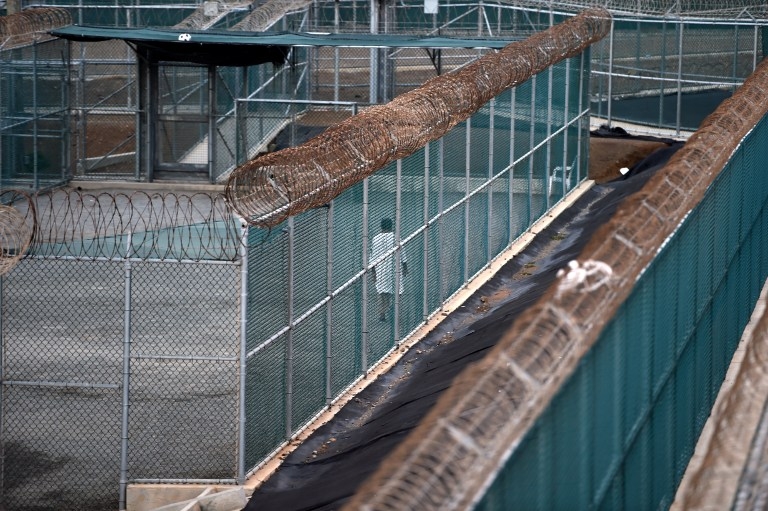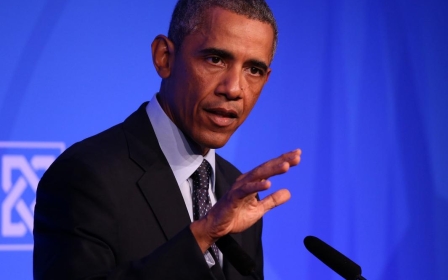Thirteen years on, Yemeni prisoners await release from Guantanamo

On Wednesday the Pentagon transferred five Yemenis held at Guantanamo prison to foreign custody in the first handover of detainees in 2015, sending four to Oman and one to Estonia.
The five men, who were held for a dozen years or more in the military prison at a US Navy base in Cuba, had been cleared for release back in 2010 by a multi-agency task force that included intelligence, diplomatic and military officials.
Lawyers and activists who campaigned for their release say they hope this will be part of a renewed push by President Barack Obama to close the internationally condemned jail set up in 2002 to house detainees in the US campaign against al-Qaeda.
Yesterday marked the thirteenth anniversary of the opening of the detention facility at Guantanamo.
Obama has pledged to step up efforts to close the facility, last year moving 28 prisoners out of the facility, the most since 2009. But with stiff opposition at home, particularly from Republican lawmakers who say they are wary of released detainees re-entering the fight against the US, an imminent closure of the base appears unlikely.
In Yemen, where many feel embittered by America’s support for former autocrat Ali Abdullah Saleh as well as its ongoing drone campaign against al-Qaeda, news of the release of the five men was met with relief.
“I see this as a chance that maybe, finally, this prison will be closed,” said Baraa Shiban of Reprieve, a UK-based charity that works in Yemen and represents a number of Guantanamo detainees.
“I hope that this era, where people thought it was OK to detain people indefinitely and without trial, will soon be over,” he said.
Yemeni detainees are the largest group in Guantanamo, and transferring those detainees from the prison remains an obstacle to closing it, according to human rights advocates.
More than half of the 122 detainees still held at the facility are Yemeni nationals, 47 of whom are no longer considered a security threat and have been approved for resettlement.
One man, Fahd Ghazy, transferred to Guantanamo when he was 17 years old, was cleared for transfer by the Bush administration in 2007, and again by the Obama administration in 2009. Ghazy, now 30, has spent over one-third of his life in detention.
“There is no guilt and no innocence here at Guantanamo. Those ideas are empty,” wrote Ghazy in a letter from prison in September. “I have been cleared for release since 2007 but I am still waiting for my freedom. I have been waiting a lifetime just to start my life again".
Ibrahim al-Qatabi, a legal worker at the Center for Constitutional Rights who last year travelled to Yemen to help produce a 10-minute documentary about Ghazy’s family, said that many Yemenis in Guantanamo had been detained simply “because of their citizenship”.
“Many were taken because they were Yemeni. Now they have been cleared, they need to be resettled, the time has come for Obama to fulfil his promise,” said Qatabi.
Another detainee, Emad Hassan, who, according to Reprieve, was abducted by bounty hunters while studying in Pakistan and sold to US forces, ended up in Guantanamo because of a mistake he made during the confusion of his interrogation. (Hassan told his interrogators he knew about ‘Al Qa’idah,’ referring to a small village with that name near his hometown in Yemen.)
Hassan, who was cleared for release in 2009 by six different branches of the US government, including the FBI and the CIA, has been on hunger strike since 2007, longer than any other detainee.
The US banned transfers of Yemeni detainees to Yemen after Umar Farouk Abdulmutallab, a Nigerian man, attempted to blow up an airliner on Christmas Day 2009 with an underwear bomb made by a Yemen-based terror group.
The Yemeni government has since proposed building a “rehabilitation center,” modeled after Saudi Arabia’s programme, which has processed scores of former Guantanamo detainees.
One reason that Yemeni detainees are not being released, analysts say, is because of the difficulty of convincing third countries to take custody of the prisoners.
“The US doesn’t want them on their soil and is hesitant to send them back to Yemen where they are operating a drone programme and there is risk of re-radicalisation, so they have to convince their allies abroad - countries like Georgia and Slovakia - to take them,” said Ruth Blakeley, a lecturer in politics at Kent University and co-founder of the Rendition project, which investigates US-led rendition and detention since 2001.
In 2014 the US negotiated to send seven Yemeni detainees to Georgia, Slovakia, and Kazakhstan.
Blakeley said that Obama’s decision to transfer the five Yemenis out of custody may have been prompted by the publishing of the CIA torture report last month.
“The report revealed the nasty side of US foreign policy but it also created an opportune moment for Obama to act while the spotlight is on the issue of illegal detention and rendition,” she said.
Shiban, the Reprieve worker in Yemen, said that he had spoken to Yemeni officials and that they had no idea about the release of the five Yemenis.
“I talked to a senior official yesterday; he wasn’t aware of the discussions," said Shiban. "The Americans have made it clear a number of times that they don’t want those detainees back in Yemen so as far as they’re concerned it’s none of Yemen’s business".
Middle East Eye propose une couverture et une analyse indépendantes et incomparables du Moyen-Orient, de l’Afrique du Nord et d’autres régions du monde. Pour en savoir plus sur la reprise de ce contenu et les frais qui s’appliquent, veuillez remplir ce formulaire [en anglais]. Pour en savoir plus sur MEE, cliquez ici [en anglais].




